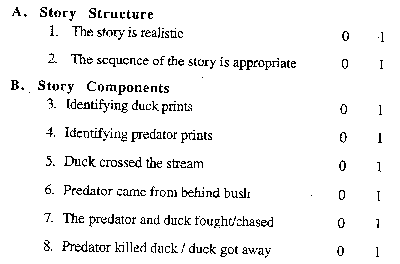Contributed by: New York State Alternative Assessment in Science
Project (NYSED)
1996 Administration
Maximum Score - 8 Points
| A. Story structure |
2 points total |
Standard: The student will write an appropriate story for
the tracks picture.
Point Criteria:
- 1 point for each of the following story structures:
- The story should be realistic, based on the given picture.
The animals do not talk or have human qualities.
- The sequence of the story must be appropriate based on the
given picture.
| B. Story components |
6 points total |
Standard: The student will include appropriate story components
about the tracks picture.
Point Criteria:
- 1 point for each of the following story components:
- Identifying one set of tracks as being duck tracks.
- Identifying the second set of prints as being a predator
of the duck. The student does not necessarily have to name
an animal, but if he/she does, it must be an acceptable predator
of a duck.
- Indicating the duck somehow crossed the stream.
- Indicating that the predator came from behind or near the
bush/tree/plant. The student does not necessarily need to
correctly identify the plant.
- Indicating or implying that the predator and the duck fought/struggled
or chased around.
- Indicating that either the predator killed an/or ate the
duck or that the duck somehow managed to escape and flew away.
*** Other creative or alternative stories may be
appropriate. Scorers should be open to these possibilities and not
penalize that student for such.
|
Highest possible score - 8 points |
| Student ID _______________________________ |
Scoring Form - Follow Those Tracks |
| Male or Female (circle one) |
|
Circle the student's score for each question. Add the points for
each question and write the total score at the bottom of the scoring
form.

| |
Total Score _______________________________ |
| |
Total possible score - 8 points |
NYS Alternative Assessment in Science Project
NSF Grant #MDR-9154506
Copyright, April 1996
The State University of New York
The State Education Department
Albany, New York 12234
|


